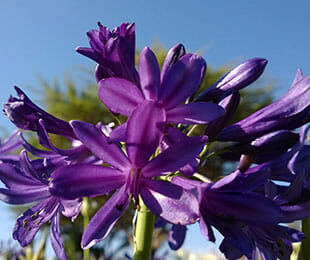Agapanthus Breeding: Tips for Expanding Your Plant Collection
Agapanthus Breeding: Tips for Expanding Your Plant Collection
Blog Article
Mastering the Art of Agapanthus Care: Important Actions for Healthy Development and Dynamic Blossoms
In the realm of horticulture, the farming of agapanthus stands as a fulfilling endeavor for those that seek to nurture these elegant flowering plants. With their striking blooms and graceful foliage, agapanthus has actually recorded the attention of garden enthusiasts worldwide. However, accomplishing ideal development and vibrant blossoms needs a nuanced method that encompasses different vital actions. From choosing the appropriate range to understanding trimming techniques, the trip in the direction of cultivating flourishing agapanthus plants is diverse and holds the vital to unlocking the full possibility of these herb treasures.

Choosing the Right Agapanthus Variety

When selecting the ideal Agapanthus selection for your yard, take into consideration elements such as climate viability, blossom color, and development habit. Agapanthus, typically known as Lily of the Nile or African lily, is available in a selection of shades ranging from shades of purple and blue to white. Pick a flower shade that complements your existing garden palette to develop an unified landscape. In addition, take into consideration the environment in your region to guarantee the Agapanthus selection you select can grow in your specific problems. Some varieties are much more forgiving of cool temperatures, while others favor warmer climates. Recognizing the growth habit of different Agapanthus ranges is critical for correct placement within your yard. Some ranges have a clumping development practice, ideal for containers or boundaries, while others have an even more spreading nature, suitable for ground cover or mass plantings. By thoroughly evaluating these variables, you can choose the excellent Agapanthus range to improve the charm of your garden.
Perfect Growing Conditions
Thinking about the optimal ecological needs is important for successful Agapanthus farming. Agapanthus plants are delicate to cool temperatures and must be protected from frost throughout winter months.
To ensure healthy development and vivid blossoms, plant Agapanthus light bulbs at a deepness of about 2-4 inches and room them 8-12 inches apart. Mulching around the base of the plants aids preserve dampness and reduces weed development.
Watering and Feeding Tips
Preserving proper dampness degrees and supplying essential nutrients are crucial elements in the care routine for Agapanthus plants. When it comes to watering Agapanthus, it is important to strike a balance. These plants choose regularly wet soil but are at risk to root rot if overwatered. Throughout the growing period, water deeply once a week, making sure the soil is well-draining to stop waterlogging. In hotter climates or throughout durations of drought, more regular watering may be needed to keep the soil uniformly damp. Nevertheless, lower watering in the winter to stop waterlogged problems.
Fertilizing Agapanthus is essential for advertising healthy and balanced growth and respected blooms. Use a well balanced plant food, such as a 10-10-10 formula, in the very early spring as brand-new development arises. By adhering to these watering and fertilizing ideas, you can ensure your Agapanthus plants grow and generate vivid, long-lasting blossoms.
Trimming Strategies for Agapanthus
Pruning Agapanthus plants at the ideal times and with proper methods is crucial for keeping their wellness and promoting optimum development and blooming. The suitable time to prune Agapanthus is in late winter months or very early springtime before brand-new development emerges.
Deadheading spent blossoms can additionally redirect the plant's energy into generating even more blooms instead than setting seeds. If you desire to accumulate seeds for proliferation, leave some blossoms to fully grown and dry on the plant.
Remember to use clean, sharp devices to make accurate cuts and reduce the risk of introducing conditions. Agapanthus. Routine pruning will help maintain your Agapanthus looking healthy and balanced and cool while ensuring a plentiful display screen of stunning flowers
Taking Care Of Common Pests and Diseases
After guaranteeing correct pruning techniques for Agapanthus, it is vital to deal with common insects and illness that can influence the wellness and vitality of these plants. One common insect that impacts Agapanthus is the Agapanthus gall midget.
One more go to website typical concern is fungal leaf area, which offers as dark sores on his response the leaves. To avoid fungal illness, make certain excellent air blood circulation around the plants, prevent overhead watering, and eliminate any contaminated leaves without delay. In addition, Agapanthus plants can struggle with origin rot if they are planted in improperly draining pipes dirt. To avoid this, plant Agapanthus in well-draining dirt and prevent overwatering. By being alert and taking timely action versus conditions and pests, you can help your Agapanthus plants prosper and generate vibrant blooms.

Verdict
In final thought, grasping the art of agapanthus care involves choosing the appropriate selection, giving ideal planting problems, correct watering and feeding, ideal trimming strategies, and attending to typical pests and illness. By complying with these crucial steps, you can make sure healthy growth and vivid blooms for your agapanthus plants. Remember to routinely check and keep your plants to promote their overall well-being and long life.
To make sure healthy growth and vibrant blossoms, plant Agapanthus bulbs at a depth of regarding 2-4 inches and space them 8-12 inches apart. By adhering to these watering and fertilizing pointers, you can ensure your Agapanthus plants grow other and generate dynamic, resilient flowers.
One common bug that influences Agapanthus is the Agapanthus gall midge. Additionally, Agapanthus plants can experience from root rot if they are planted in badly draining pipes dirt. By complying with these crucial actions, you can ensure healthy growth and lively blossoms for your agapanthus plants.
Report this page